Even the most minor details regarding hair transplant surgery can go a long way. To give patients more natural-looking results with FUE surgery, surgeons must pay particular attention to the hairline and edges. Hairline reconstruction requires careful consideration of what would look most natural to frame the face better–the hairline is, after all, prominent. Thinning and recession can disrupt the overall aesthetic balance. Ultimately, the goal of hair transplant surgery is for patients to have a fuller head of hair that does not give away the fact that a procedure has been done. However, most clinics use the traditional donor area on the back of the head in hairline reconstruction surgeries, which may result in harsh-looking pluggy hairlines. If surgeries neglect to reproduce accurate life details, the patient won’t have natural-looking results and will continue to have a bad hairline. This begs the question: how should hair surgeons give their patients a better, fuller hairline?
According to Dr. Sanusi Umar, the head of the hair & scalp disorders section of Harbor-UCLA medical center and owner of Dr. U Hair and skin clinic in Manhattan beach California, the solution lies in the use of finer hairs to produce softer hairlines. Dr. Umar extracts finer hairs using an advanced FUE system, which he developed called the Dr.UGraft Zeus; coupled with its intelligent punch ™, Dr. Umar can harvest follicles from nontraditional donor areas, such as the nape and the peri-auricular regions, that closely match the natural hairs found along the hairline. Nape hair can be beneficial as it can expand the donor supply of a patient by up to 3,000 grafts and create softer hairlines and temples.
Article Update July 7, 2022:
Since the original article, one relevant development in the field of FUE is the recent publication of a new all-purpose FUE device called Dr. UGraft Zeus, which functions based on skin thickness and firmness. In addition, the Zeus device has a preset for extracting nape hair, which makes BHT (Body Hair Transplant) and nape hair transplant much more manageable and feasible.
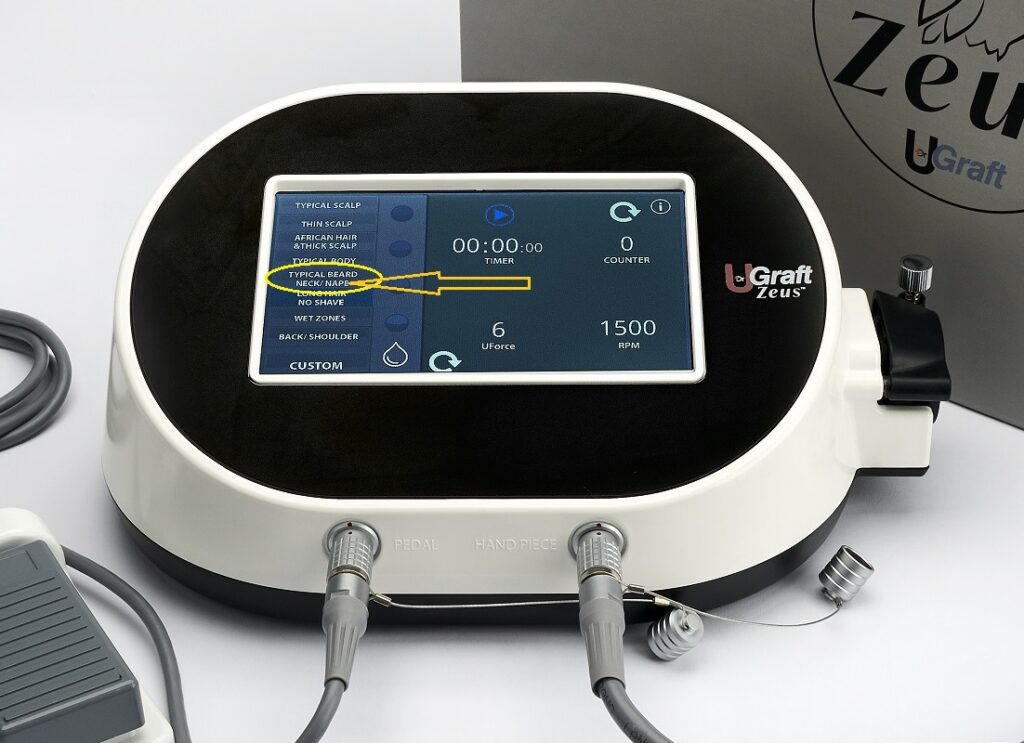
Fixing a Bad Hairline with Nape Hair
In an academic study about using nape hair for FUE hairline surgery, a group of patients reported feeling happy and satisfied with their softer, more natural-looking hairline. Many clinics, however, continue attempting to fix bad hairlines with hair from the safe donor area on the back of the head due to the assumption that all patients experiencing hair loss will continue into a Norwood 7 stage of severe balding. In the Norwood 7 stage, all peri-auricular, nape, and temple hair are lost. However, a report by Dr. Walter P. Unger in Hair Transplant Forum International found that in 328 patients studied 65 years of age and above, only 20% had Norwood 7 level baldness.
Umar’s FUE Hairline Surgery Using Nape Hair
Dr. Umar’s integration of nape hair into the hairline can achieve a more natural-looking result for individuals with a receding or lousy hairline. Nape hair tends to be very thin and makes a realistic graft choice for the outer hairline edge. Dr. Umar performs his Shave Test to see if a patient is a good candidate for this surgery. In this test, Dr. Umar shaves the nape and lower scalp areas to look closely at hair patterns in that area. Suppose there’s a significant line of demarcation. In that case, the patient will likely reach a Norwood 7 level of baldness, and nape hair would have a very low probability of surviving after a hairline reconstruction surgery. However, Dr. Umar has found that about 75%-80 patients are good candidates. After determining that a patient can undergo FUE hairline surgery, Dr. Umar uses his Dr. UGraft Zeus device to extract follicles from the nape area safely.
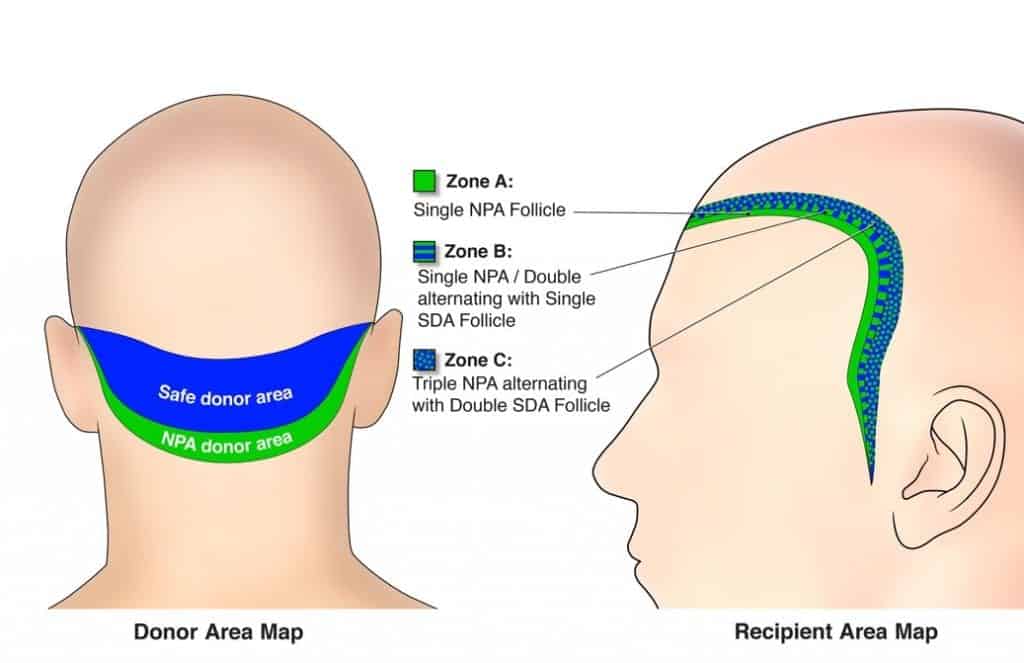
Dr. Umar’s surgery also ensures that patients have a natural-looking hairline by taking account of the edges. A common mistake in FUE hairline surgeries is that surgeons only use thick donor head hair along the edge of the hairline. Natural hairlines edges should be subtly thinner than the rest of the hair and gradually increase in thickness towards the back of the head. This is a nuance that Dr. Umar pays close attention to in his hairline reconstruction surgeries. It is essential to keep these details in mind to fix a bad hairline. Though having an FUE hairline surgery is nothing to be ashamed of, if everyone can tell you had a hairline restoration surgery, this means it looks unnatural. Extracting hair from the nape and then transplanting it to the hairline could ease that potential anxiety for patients.
The “before” section of the patient’s “before and after” picture below exemplifies the embarrassing situation mentioned above. The patient had undergone previous strip surgeries at other clinics, but the strip surgery technique could not replicate a realistic, natural-looking hairline. This resulted in a lot of unwanted attention to the patient’s hairline. After consulting with Dr. U in Los Angeles, Dr. U recommended a hairline reconstruction using 3,000 grafts from the nape and head.
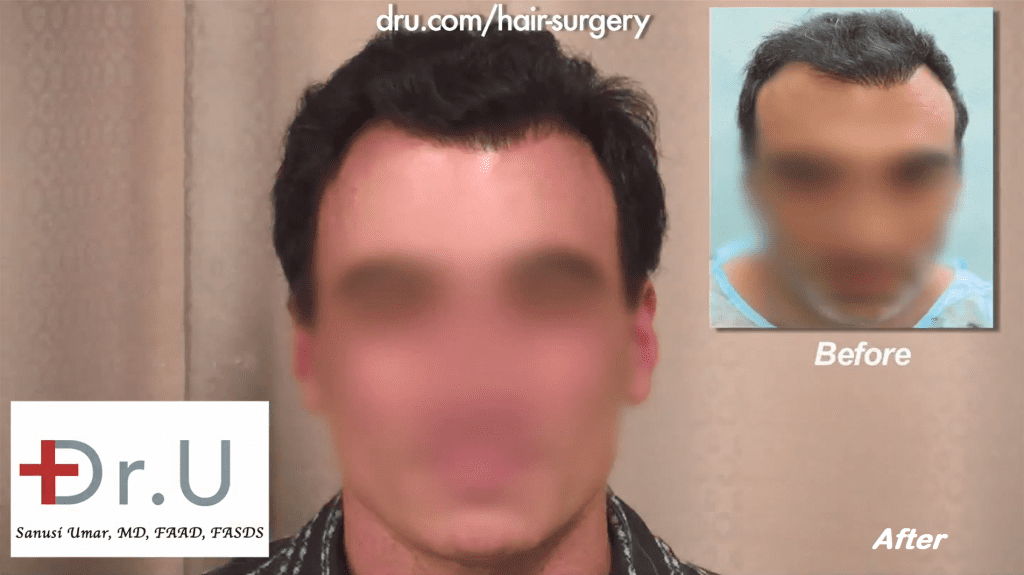
If you want to know whether you could qualify for a hairline reconstruction surgery using nape hair, schedule a free consultation with Dr. U today!
Hairline Reconstruction With FUE Shave Test
In the example below, the back and sides of the patient’s head were shaved with a guard-less electric clipper into a tight crew cut. This allows Dr. Umar to screen for nape hair transplant candidacy with direct visualization. The gradual transition in density from the safe donor area to the nape indicates that the patient’s hair loss will not progress into the Norwood 7 stage.
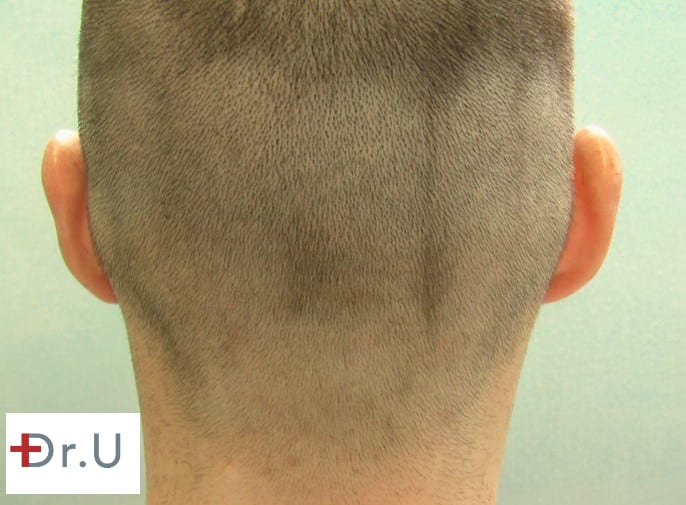
According to Dr. U’s FUE Shave Test results, the patient pictured below did not qualify for a hairline reconstruction surgery using nape hair. Dr. U determined the progression of diminished hair caliber and density from the safe donor area to the nape to be drastic, with a well-defined line of demarcation. Occasionally, individuals who fail the FUE Shave Test exhibit isolated patchy areas of hair loss in the nape and the peri-auricular regions.
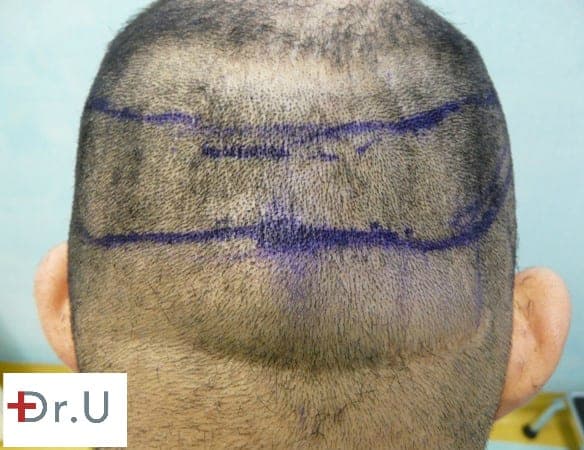
If a patient fails the FUE Shave Test, fine hairs from the body can be extracted in an advanced FUE body hair transplant procedure to create a soft, natural-looking hairline. The results of Dr. U’s Shave Test can also be beneficial for young men facing hair loss, as it could give them insight into how their hair loss might progress and help plan for future hair transplants.
Fixing a Bad Hairline With Temple Hair Reconstruction
The patient below was unhappy with his hairline and how far it had receded. To provide a more youthful hairline, Dr. U took the temple points of the patient into account. The temples and hairline require attention to detail, as the wrong angle or position can result in a bad hairline.
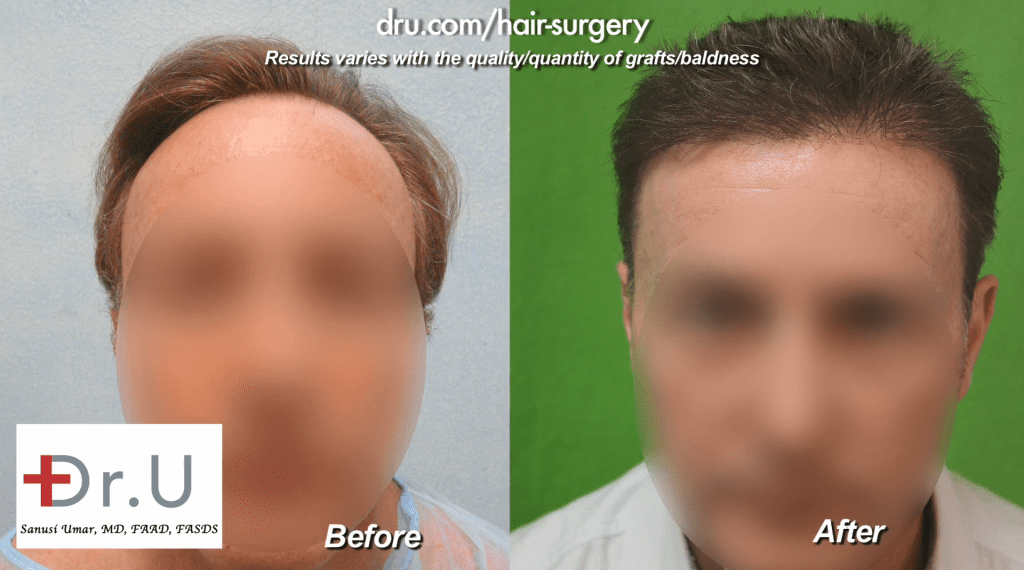
Nape hair proved helpful in the case of the patient above in creating a lower, bolder hairline. In addition, the temple points help to create a realistic, neutral hairline that compliments the patient’s facial features.
FUE Hairline Reconstruction Using Nape Hair Before and After Photos
Pictured below are some patient results from Dr. U Hair Clinic. The patient immediately below was unhappy with his angular, “M” shaped hairline, accentuating his widow’s peak and giving him a “Dracula” look. So, Dr. U extracted 600 grafts from the nape and head to bring the temple points forward and eliminate the “Dracula” look.
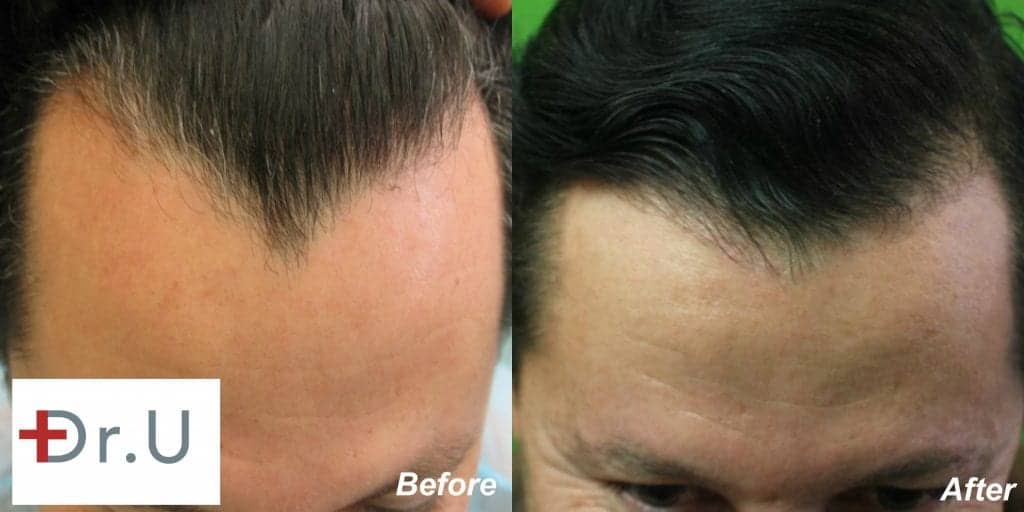
The patient was concerned with his receding hairline and thinning at the top in the case below. By redefining the temples and adding density to the hairline with more delicate nape hairs, Dr. Umar created a realistic hairline for the patient.
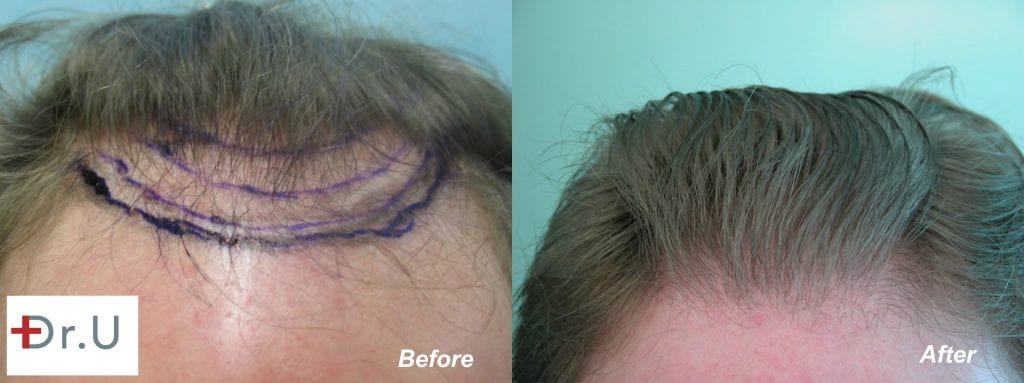
VIDEO: FUE Hairline Reconstruction Using Nape Hair
The patient in the video below came to Dr. U because he wanted a natural-looking hairline that would not attract attention. In other words, an undetectable hairline finish. He also wanted the restoration to be very conservative, so it is not obvious he did something. Dr. U achieved these goals by utilizing 1000 grafts derived from the nape and head area. Resulting in a softer, very natural look.
Unnoticeable Hair Transplant By Dr U: How To Get A Hair Transplant You Can Deny To Friends Or Family
No Description
Do You Want To Fix Your Receding Hairline?
If you are interested in successful hairline reconstruction or want more information about FUE surgery, schedule a free consultation with Dr. Umar today!
Frequently Asked Questions: Hairline Reconstruction
What if I have a bad hairline and am not a good candidate for hairline reconstruction using nape hair? Can I still get an FUE hairline surgery?
If a patient is found to be a poor candidate for a nape hair transplant after conducting the Shave Test, Dr. Umar can still perform an FUE hairline surgery. However, instead of using hair from the nape of the neck, Dr. Umar can extract body hair using the Dr.UPunch Rotor™ that matches the satisfactory caliber of hair found around the edge of a hairline.
What is the difference between a natural and an unnatural-looking hairline?
A natural-looking hairline is characterized by the use of progressively fine and less dense hairs until the bare skin of the forehead is visible. An unnatural-looking hairline, by contrast, is characterized by the use of coarse, densely packed hair. Hairline reconstructions at most clinics are performed using hair from what is considered to be a safe donor area on the back of the head. However, since the caliber of follicles harvested from this area is naturally more thick and coarse than the caliber of hairs found on the hairline, their use can result in an unpredictable-looking hairline. This is why Dr. Umar prefers to extract more delicate hairs and implant them throughout the hairline to soften the line and fill in the spaces where the scalp is visible.
Why are other clinics less equipped to use nape hair in an FUE hairline surgery?
Dr. Umar uses his Dr.UGraft method to harvest hair from nontraditional donor areas. First, he uses his Shave Test to determine if nape hair is even a viable option–this saves the patient from committing to a hair transplant only for the hair to fall out if his baldness progresses. Then, if a candidate passes the Shave Test, Dr. Umar can extract the fine hairs along the nape using the Dr.UGraft Rotor™ without the fear of them falling out due to the progression of baldness. Other clinics are less equipped to extract more delicate hairs because basic FUE rotors could either transect the hair shaft, damage the follicles by exposing them to air, or damage the follicles by handling them with mechanical tools like forceps.
It would not be easy to expound upon all of the benefits nape hair has to offer anybody interested in restoring a receding hairline. If your questions haven’t been addressed here, we invite you to send them to Dr. U himself via the following link:
Further Reading
Click here to read about how Dr. U fixed a receding hairline and see a patient example!
References
- Umar S, Lohlun B, Ogozuglu T, Carter MJ. A novel follicular unit excision device for all-purpose hair graft harvesting. Clinical, cosmetic, and investigational dermatology. https://www.ncbi.nlm.nih.gov/pmc/articles/PMC8605797/. Published November 16, 2021. Accessed July 6, 2022.
